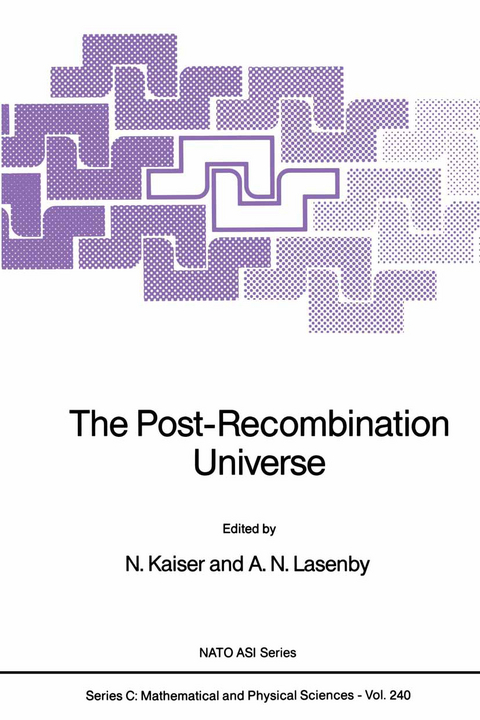
The Post-Recombination Universe
Springer (Verlag)
978-94-010-7864-1 (ISBN)
I Sources at High Redshift.- “Protogalaxies”.- “The Search for High Redshift Quasars”.- “Cosmological Evolution of Extragalactic Sources”.- “The Evolution of Extragalactic X-ray Sources”.- “HII Galaxies”.- “The Redshift Cutoff for Steep-Spectrum Radiogalaxies”.- “Quasars Contributing to the Extragalactic X-ray Flux: the Deep X-ray Survey in Pavo”.- “The Milli-Jansky Radio Galaxies”.- “Cosmogonic Implications of the First Quasars”.- II Background Radiation Fields.- “Measurements of CBR Anisotropics at Intermediate Angular Scales”.- “Cosmological Implications of the Infrared Background Radiation”.- “Origin and Anisotropy of the Cosmic Submillimeter Background”.- “Non-Gaussian Statistics and the Microwave Background”.- “Cosmological Gravitational Waves”.- “The Infrared Background from Stars at High Redshift”.- “Large-Scale Microwave Background Anisotropics in Cosmological Models with Exotic Components”.- “Microwave Background Radiation Observations at the Owens Valley Radio Observatory”.- “Microwave Background Radiation Observations at the Owens Valley Radio Observatory: Analysis and Results”.- “On Measurements of the Zeldovich-Sunyaev Effect”.- “Prospects for Sunyaev-Zeldovich Astronomy”.- “The Constraints on Superconducting Strings”.- “Horizon-Size Cosmic Strings”.- III Absorption Line Systems.- “Metal-Rich Absorption Line Systems”.- “The Periodicity in the Redshift Distribution of Primordial Hydrogen Clouds”.- IV Galaxy Clustering and Large-Scale Structure.- “Quasar Clustering and Gravitational Lenses”.- “X-rays and the Large Scale Structure of the Universe”.- “Monte Carlo Simulations of Large-Scale Streaming Velocities”.- “A Test on the Gaussian Nature ofPrimeval Fluctuations”.- “Can Explosions Generate Filaments and Voids?”.- “Models for the Evolution of the Two-Point Correlation Function”.- “Some Possible Mechanisms for the Formation of Large Scale Structures in the Universe”.- “Evolution of Quasar Clustering”.- “From 2-D to 3-D by Maximum Entropy Method”.- “Cluster-Galaxy Cross-Correlations”.- “Cluster Correlations in Cold Dark Matter Scenarios”.- “Cosmic Strings and the Large-Scale Structure”.- “The 3-D Distribution of Abell Clusters”.- “Quasar Pairs, Clustering and its Evolution”.- V Gravitational Lensing.- “Gravitational Lenses”.- “Gravitational Micro-Lensing as a Clue to Quasar Structure”.- “Gravitational Lensing by Clusters of Galaxies”.- “Properties of Gravitational Lens Mappings”.- VI Galaxy Formation Theory.- “The Formation of Elliptical galaxies”.- “Self-Similar Inhomogeneous Cosmological models”.- “Cosmic Strings: A Problem or a Solution?”.- “Galaxy Formation with Neutrinos and Cosmic Strings”.- “Gauge Invariant Cosmological Perturbation Theory for Collisionless Scenarios”.- “Extending N-Body Methods with SPH”.- “Galaxy Formation in the Cold Dark Matter Cosmogony”.- “The Growth of Angular Momentum Near Density Peaks”.- “The Morphological Luminosity Function”.
| Reihe/Serie | NATO Science Series C ; 240 |
|---|---|
| Zusatzinfo | 408 p. |
| Verlagsort | Dordrecht |
| Sprache | englisch |
| Maße | 155 x 235 mm |
| Themenwelt | Naturwissenschaften ► Physik / Astronomie ► Angewandte Physik |
| Naturwissenschaften ► Physik / Astronomie ► Astronomie / Astrophysik | |
| Naturwissenschaften ► Physik / Astronomie ► Relativitätstheorie | |
| Technik ► Luft- / Raumfahrttechnik | |
| ISBN-10 | 94-010-7864-5 / 9401078645 |
| ISBN-13 | 978-94-010-7864-1 / 9789401078641 |
| Zustand | Neuware |
| Haben Sie eine Frage zum Produkt? |
aus dem Bereich


